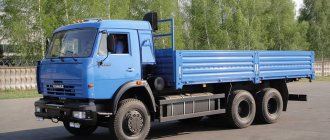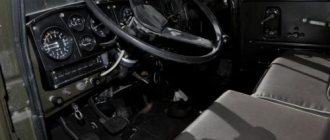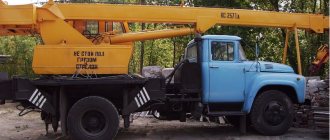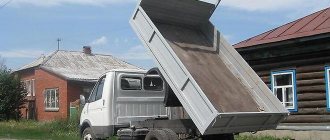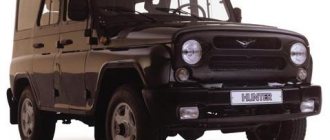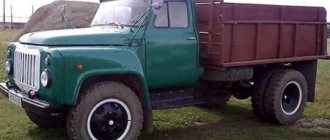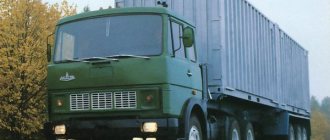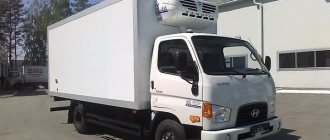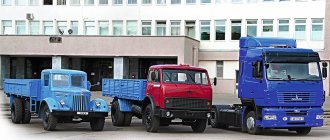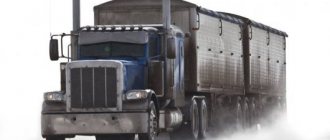For questions regarding the purchase of this equipment (ZIL 433360 flatbed 4x2), terms of credit and leasing, service and warranty, please contact the plant’s dealers or official representative offices. Delivery of ZIL 433360 flatbed 4x2 can be carried out either directly from the manufacturer or from sites in Moscow and other regions of the Russian Federation.
The ZIL flatbed truck is designed for transporting various cargoes on all types of roads.
Specifications
It is interesting to note that although the car was planned to be the younger brother of the base 4331, its load capacity did not decrease, and the newer engine only increased the number of sales of the lightweight version.
Repairers noted that if you change the gearbox to a standard 9-speed one, you get a shorter truck with a better engine (meeting Euro-3) and better maneuverability. Descriptions of the technical characteristics of this car noted the unpretentiousness inherited from the ZIL 130 and the modern electronic filling from the 4331. Thanks to this, the 360 was modified several times, and the constant demand for this model forced the ZIL team to resume its production.
According to special orders, the truck was equipped with an additional cabin cooling system and insulation covers, a microprocessor ignition system and engine preheating. For the customer, the carburetor engine could be replaced with a diesel engine D 245.9.
Fuel consumption of 20 l/100 km and a tank of 170 l made it possible to travel from 450 to 600 km at one gas station. The final numbers depended on the conditions of use.
Repair manual
When engaged in repairs and diagnostics of this car, specialists often forget that in front of them is only one of the successful modifications of the 4331 model. Therefore, the ZIL-433360 repair manual may not exist.
If necessary, you must use documents from earlier models of this series, since many solutions are identical for all machines.
The cardan transmission system involves a pair of shafts, between which there is an intermediate clutch support. The car's clutch repeats the design previously used in the 130 model - a classic basket with a release bearing, controlled by a pneumatic drive.
When reading the operating and maintenance instructions for this vehicle, the user must understand that all additional equipment options were not displayed in it. The most commonly described is a “pure” 360. Therefore, you will have to look for additional equipment diagrams yourself.
On the other hand, we should not forget that the car is an updated 130 version and, despite the assurances of the designers about the new car, many of the details remain the same. And if the driver confidently repaired the previous version, he will figure it out here too. Experience is independent of model number.
Peculiarities
Among the main features of the ZIL 4333 model, the following should be noted:
- Lubrication points. For more convenient service, the number of points has been reduced;
- Brakes. For its time, the truck's braking system was quite effective. Moreover, it has a system for automatically adjusting the pads depending on their wear;
- Maintainability. Despite the fact that the ZIL 4333 is no longer produced, finding any spare parts for it even now will not be difficult. In addition, the design is made as simple and understandable as possible, which allows repair work to be carried out practically in the field;
- Interior sealing. The interior of the car is very well sealed, so that when working in dusty conditions, dust and other particles do not get inside;
- Seat belts. Since the cabin has three seats, the designers used seat belts for each of them.
- Maneuverability and maneuverability. Compact overall dimensions allow the truck to be used in conditions of limited free space, and the high ground clearance and short wheelbase provide it with excellent cross-country ability even in off-road conditions, although not severe, since all-wheel drive is still missing.
According to many drivers, the ZIL 4333 is in many ways superior to its predecessor ZIL-130. The truck has a contactless ignition system, a more comfortable driver's seat, more convenient access to the power unit and many other components located in the engine compartment and improved visibility.
Although the ZIL 4333 truck has a large number of excellent reviews, it still could not gain much popularity in the Russian market. Moreover, it is even significantly inferior to its similar foreign-made models. This is primarily due to high fuel consumption, which made it uneconomical for many consumers to use it. In addition, it has a low load capacity. However, due to ease of maintenance and low cost, ZIL 4333 has found a niche in some areas of industry, especially in rural areas.
Price and analogues
Apart from ZIL's own developments and modifications, which are based on the onboard 4331 - the prototype for the model 433360, this car has no analogues. An indirect analogue can be called KamAZ models with a 4x2 wheel arrangement, but the different cab concept, layout of components, and also the fact that the plant in Naberezhnye Chelny produces trucks to a limited extent, they are not suitable for a full replacement of Zila vehicles.
Thanks to consumer demand, AMO ZIL tried to revive an American-made diesel car, but the transition to market relations killed this project. 433360 is one of the few models of the plant that was produced until its closure in 2016. According to estimates from various sources, the cost of the car starts from 300 thousand rubles. The final figure depends on the condition and configuration.
Overview of the main technical characteristics of the truck
The technical characteristics of model 4334 vehicles allow, when moving on a hard road surface without a trailer, to cope with an incline at an angle of 35° and a ford with a level of up to 1.4 m. This is possible thanks to the presence of a powerful (170 hp), multi-fuel, 4-stroke, 8 -cylinder, V-shaped diesel engine model ZIL 6451 with overhead valve water cooling. The diesel power is enough to accelerate an SUV weighing 11,170 kg to 90 km/h. In first gear, this model moves stably at a speed of 3.5 km/h.
All copies of the ZIL 4334 brand have electrical equipment with a voltage of 24 V. External and internal components are powered by a generator and 2 batteries. Their adjustment consists of analyzing the connection and checking the amount of electrolyte. Devices and signaling devices mounted on the dashboard make it possible to monitor the condition of the engine, generator, as well as the air pressure in the brake system. The three-axle dump truck of the ZIL 4334 family has a reinforced 5-speed manual gearbox, an improved 2-speed transfer case, and a frame with side members thickened to 8 mm.
The initial element connecting the engine with other parts of the transmission is a clutch with a hydraulic drive, pneumatic booster and peripheral placement of springs. Each gear, with the exception of the first, operates synchronously in the gearbox. The transfer case drives all vehicle axles. To prevent multiple gears from engaging together, there is a ball locking device.
A new development for SUVs of this model is the automation of the front axle launch control when shifting to zero gear. The front axle is forced to engage, for example, when the car is moving along a slippery road in direct gear. To close the electrical circuit, you can use the switch on the panel.
On the surface of the transfer case there is a special hatch for mounting a 60 hp power take-off device. to drive various components when the chassis is used to attach additional equipment.
Important TOP 3 representatives from the Lynx brand chainsaw model range
As the ZIL 4334 manual indicates, all three vehicle axles are driving. The middle axle is intermediate, from it the power flows to the rear axle. To increase traction power when driving in difficult places, the drive axles are equipped with forced locking.
The two pairs of driveshafts connecting the disparate transmission units feature splined configurations and heavy-duty bearing joints. The steering mechanism has a hydraulic booster. The steering wheel position can be individually adjusted for level and tilt. Turning diameter up to 20 m.
Power supply circuits, fuel, completeness
All consumers need a voltage of 12 V. They are connected to the common circuit with one wire. If you want to measure the potential on a consumer, you need to connect one voltmeter probe to its terminal, and touch the car body with the second.
Accordingly, the “negative” wire of the starting battery 6-ST-78 (6-ST-81), having a capacity of 78 (81) Ah, is also connected to the “ground” of the machine.
During engine operation, the source of energy for all standard and brought-in electrical appliances is the G130 generator, which provides a current of 28 A and 350 W of power.
A special regulator maintains a constant voltage level from the generator to recharge the on-board battery and power the devices. This may be an electromechanical device or a more complex and precise modern electronic circuit.
The fuel capacity is 170 liters. The manufacturer's recommended fuel is AI-92 gasoline. The tank volume, depending on conditions, is able to provide a travel range from 450 to 690 kilometers.
The demand for the ZIL-433360 model, which is essentially a modernized version of the inexpensive ZIL-130, long known for its high reliability, led to the resumption of custom production of this 360 series at the AMO Plant named after. Likhachev."
All units can be additionally equipped with:
- insulating covers;
- cabin cooling systems;
- additional resting place for the second driver (sleeper) with electric heating;
- microprocessor ignition system;
- engine heating system before starting;
- timber from undercut.
If necessary, diesel engines D 245.9 with increased fuel efficiency can be installed instead of a gasoline engine.
History of the ZIL-433362 model through the prism of the history of the plant
The Likhachev plant fell just short of its 100th anniversary. At the turn of 2013/2014, the long history of the oldest domestic automaker came to an end.
The vast territory of the enterprise (this is 300 hectares, almost in the center of the capital, adjacent to the Moscow River) is being built up with new residential complexes, office buildings, shopping and entertainment, only a small workshop for the production and maintenance of premium government passenger cars.
If serial production of the ZIL-4331 family dates back to 1987, then the ZIL-433362 model was developed in the late 90s of the twentieth century. At that time, the Likhachev Plant not only had not yet slipped into bankruptcy, but was even on a certain upswing, increasing production volumes and recovering from the blow dealt to it by the “shock therapy” of the 90s.
To be fair, it should be noted that the number of ZIL trucks produced in those years did not grow at all because they were very competitive, modern and in demand on the market. On the contrary, “ZIL-4331”, already in the first years of its mass production, was a hopelessly outdated “model of the last century”, and the new “ZIL-5301 Bychok” was infinitely far from perfect and was in many ways inferior to its competitors.
The demand for ZILs in the late 90s/early 2000s was largely created artificially, thanks to the incredibly energetic activities of the then capital mayor Yuri Luzhkov. Since 1997, a controlling stake in the plant belonged to the Moscow government. All metropolitan and many regional municipal and other services equipped their fleet with ZILs precisely on the urgent recommendations of Yuri Mikhailovich and his assistants.
In 1997, the most authoritative auto magazine in the country, “Behind the Wheel,” announced the release of a new model within the 4331st family. This is “ZIL-433362” - a universal chassis, maximally adapted for the successful operation of sludge vacuum installations for sewer wells and storm drains; combined road machines for street cleaning, etc.
Why is our Moscow Ring Road being cleared of snow by “their” Mercedes trucks with the Schmidt system? Disorder! Our ZIL may not be a beauty, but it knows its stuff! And instead of imported equipment, new “ZIL-433362” were purchased, with the new “PR-1 Ecomtech” system from the Ryazhsky Automobile Repair Plant. Etc.
Yuri Luzhkov sought to maintain industrial production in the capital using “administrative resources.”
In 2000, three ZIL-433420 cars, with the support of the Moscow government, made a unique round-the-world (!) motor rally along the route Moscow-Yakutsk-Uelen-North America-Western Europe-Kaliningrad-Moscow.
The first stage of the round-the-world expedition, 13 and a half thousand kilometers long, was completed in 62 days and ended in the village of Uelen on the shores of the Bering Strait (Chukotka). Then - to Alaska, and across the entire North American continent to the Atlantic. In total, the expedition on ZIL-433420 covered 45 thousand kilometers. The Moscow mayor himself rode the last kilometer, to Red Square, together with members of the expedition.
Important TOP 2 modifications of trucks based on the ZIL-MMZ-4502 dump truck
The story of the production of bells for the revived Cathedral of Christ the Savior is also memorable. 14 bells weighing between 8 kg and 27 tons were manufactured at ZIL! And then both the mayor and the entire composition of the capital’s government changed.
New officials approached the problem of the Likhachev Plant with a cold and pragmatic calculation: the plant is an asset, and it should bring profit, not hassle and losses. Without the powerful support of the notorious “administrative resource”, outdated, uneconomical and low-profitable, compared to modern competitors, ZIL trucks turned out to be completely useless to anyone.
There is no data on how many units of the ZIL-433362 modification were produced. But apparently not much. The era of gasoline-powered trucks is over, and ZIL-433362 is one of its last representatives.
Device
Inherited from its parent (ZIL-130), the car received a flatbed body, rear-wheel drive and a 4x2 wheel arrangement. According to the developers, this model was to become the younger brother of the base car of the series. In accordance with these plans, a short wheelbase chassis and a 5-speed manual transmission were used for development. The car received a cabin that completely replicates the basic version. In keeping with the fashion of those years, it has strict angularity, sharp features and a hood and front fenders connected into a single block. To access the engine compartment, it tilts forward.
A distinctive feature of the model was that it appeared on the assembly line at a turning point, when the ZIL-508.10 engine, developed specifically for it, was replaced with a newer 508300. This power unit met Euro-3 environmental standards.
In the ZIL-433360 electrical circuit, all consumers are connected to a common wire, which makes it possible to simply install and configure additional devices. The system uses 12V. When parked, power is supplied from a 6-ST-78 battery (81 in the latest versions) with a capacity of 78 Ah. During engine operation, the G130 generator produces 350 W and 28 A for the operation of all both regularly installed and external consumers.
For parking, stopping, and controlling the vehicle on slopes, the developers have provided several brake circuit systems:
The main system is activated by pressing the appropriate pedal in the cab. Each wheel has separate brake chambers controlled by a pair of independent hydraulic circuits.
The parking and spare systems are activated by turning the lever in the cab, pressing the brake pads against the axles. When driving, the main transmission circuit is activated, which automatically reduces engine speed, helping the truck stop smoothly.
Chassis wheel components and suspension
In ZIL-433360 the drive is on the driving rear wheels, the direction of movement is selected by changing the angle of rotation of the front wheels. In the factory configuration, the machine has seven disc-type wheels :
- two front wheels;
- double rear;
- one spare, suspended on the right side of the frame.
The wheel rims are mounted on the axle flanges with eight studs. The work of replacing tubes and tires is made easier by the existing split locking rings, which can be easily removed from one side of the rim.
With wheel sizes 7.0-20 and radial tube tires 260R508, it is difficult to change the tube without such a design.
The suspension of the front axle and rear axle is of a dependent type, which is explained by the presence of rigid beams on both wheel sets. Each is attached to the frame side members on a pair of semi-elliptical springs.
They perform a guiding function, and the more loaded rear ones are reinforced with additional sheets, and a telescopic hydraulic shock absorber is included with each front one.
Device
The design of this car includes such mechanisms and parts as:
- Electrical equipment responsible for light and sound signaling, low and high beam, etc.
- The transmission, which is the chassis of the vehicle.
- Steering mechanism and air suspension ZIL.
- A power unit equipped with a carburetor, a pump element and a liquid cooling system.
- Independent braking mechanism. The system consists of auxiliary, parking and service brakes.
- Clutch mechanism, wheels and tires of transport.
- A pneumatic system that includes a compressor, fitting, clamp and hoses.
- Driver's cabin and cargo platform.
Electrical equipment
The electrical diagram is in color and with a description in the vehicle repair manual.
The negative terminals of all electrical devices and ZIL devices are connected to the ground of the vehicle. The rated voltage in the wiring circuit is 12 V. The electrical circuit is represented by low voltage wires PGVA and high voltage wires PVV.
If the break occurs on low voltage wires, you can wrap the damaged area with insulating tape. If a break occurs on high voltage wires, they should be replaced, because they cannot be repaired. To determine a break, it is recommended to use a probe equipped with a test lamp.
checkpoint
The transmission includes the following elements:
- drive shaft;
- bearing;
- retaining and sealing rings;
- locking spring mechanism;
- gears;
- gear shift fork;
- sleeve;
- control and filling hole plug;
- axial device of the intermediate lever;
- driven shaft;
- speedometer;
- pin.
The gearbox is equipped with the gears needed to engage second, third and fourth gear.
Assembly of the mechanism after repair work is carried out only with the power unit turned off.
Mechanism gear ratios:
- first gear - 6.45;
- second gear - 3.56;
- third gear - 1.98;
- fourth gear - 1.275;
- fifth gear - 1.00.
Steering
The ZIL steering system consists of:
- hydraulic booster pump;
- tank;
- low pressure hose of the pumping element;
- steering column control;
- switch;
- cardan shaft;
- fastening elements;
- crankcase;
- slats;
- a wedge that is needed to secure the driveshaft;
- contact device;
- high pressure pipes;
- bipod;
- oil radiator.
Important How to assemble a homemade tractor from a walk-behind tractor or a car
Hydraulic power steering makes it possible to reduce the level of load and effort that is applied to turn the front wheels of the vehicle. This device helps soften impacts during off-road driving and allows you to maintain control over the vehicle's steering if a front tire tire breaks.
Body
Body dimensions and volume:
- length - 6675 mm;
- height - 2400 mm;
- volume - 5 m3.
The permissible lifting angle of the dump truck is 50°. Unloading can be done backwards, to the right or to the left. The platform area is 8.7 m2, and the parameters are 2325-3752 mm.
The design of the vehicle body includes:
- sides;
- fasteners;
- base;
- bolts;
- tension loops;
- longitudinal beam;
- frame;
- clamp;
- splash guard;
- bracket and bracket bolt;
- auxiliary block.
The total number of sides is 6. The base of the structure is made of durable metal, it is possible to install an awning. The flooring on the base is made of wood, and the sides are presented in the form of profiled panels, which are made of sheet steel.
Cabin and driver's workplace
All-metal cabin with a layout of two volumes:
- interior salon;
- engine compartment space.
The welded rigid metal structure is equipped with a one-piece panoramic windshield. It is tightly attached to the opening of the front window using a special rubber seal without the possibility of opening.
The ZIL-433360 cabin is designed for three seats (including the driver's). Its attachment points are on adjustable brackets with rubber shock absorption in three places of the supporting frame. The right and left are on the longitudinal spars, the rear is on the second frame crosspiece.
The design of the cabin includes external elements (tail) to protect parts and components of the machine’s mechanisms located outside the interior cabin:
- hood,
- wings,
- radiator trim,
- side steps.
Both doors on the sides have:
- roll-down window , fixed in the upper position by a single-lever lift;
- rotating window with locking handle and built-in locking button;
- locks that can be locked from the outside with a key;
- a locking handle that locks the door from the inside , excluding external opening;
- an extended arch-bracket with fastening of a side car rear view mirror of a larger area, guaranteeing confident control by the driver of the situation on the road behind and to the sides.
The swivel mount makes manual viewing angle adjustment easy.
The cabin meets modern ergonomics and standards of working comfort for the driver and passengers.
The adjustable work seat is equipped with a spring mechanism.
The doors, which open in enlarged openings almost at right angles, are rationally located relative to the driver and passenger seats.
With a significant height of their plane (exceeding one meter), the convenience and safety of boarding and disembarking are ensured by wide steps under each door.
The entire layout of the controls is subordinated to the purposes of convenience:
- steering wheel , located on the left side of the cabin symmetrically with the driver's seat, almost perpendicular to the vertical of the car, which improves motor skills without causing fatigue during long trips;
- The gearbox control lever is located in front on the right above the seat level. Its height was chosen for the convenience of constant monitoring in the field of peripheral vision;
- Pressing the pedal with your left foot when operating the clutch and with your right foot when operating the brakes is performed with minimal movement and force that does not disrupt the even distribution of the driver’s body weight on the seat.
The steering mechanism is equipped with power steering. The design uses a separate layout of its elements.
The distributor is built into the steering column, and the power steering cylinder is located separately.
The integrated work of the mechanical (screw with a sliding nut that moves the gear sector) and hydraulic parts reduces the load when driving.
The width of the cabin along the mirror brackets does not exceed 2.5 m, the total height from ground level is no more than 2.66 m, the length (including the hood) is about 2.8 m.
It has two rotating sun visors and natural and forced ventilation systems, including:
- lockable air intakes;
- symmetrical air ducts with a fan.
An internal interior lighting system has been used and a stove has been equipped to heat it in cold weather, and noise and vibration insulation measures have been strengthened.
